Investigating the Emission of Hazardous Chemical Substances from Mashrabiya Used for Indoor Air Quality in Hot Desert Climate
Abstract
:1. Introduction
2. Materials and Methods
2.1. Types and Characteristics of Raw Materials
2.1.1. Fiberboard
2.1.2. Glued Laminated Timber
2.2. Types and Characteristics of Surface Finishes
2.2.1. Veneer
2.2.2. Polyvinylchloride (PVC) Sheet
2.2.3. Finishing Foil (F/F)
2.3. Hazardous Chemical Emission Test Method for Mashrabiya
2.3.1. Test Piece Overview
2.3.2. Experiment Conditions and Calculation of Emission Intensity
2.3.3. Sample Collection and Analysis Methods
3. Results
3.1. The Characteristics of TVOC Emission
3.1.1. Emission Characteristics Due to Differences in Raw Materials and Surface Materials
3.1.2. Emission Characteristics Due to Differences in Retention Period
3.2. The Characteristics of HCHO Emission
3.2.1. Emission Characteristics Due to Differences in Raw Materials and Surface Materials
3.2.2. Emission Characteristics Due to Differences in Retention Period
4. Discussion
5. Conclusions
Author Contributions
Funding
Institutional Review Board Statement
Informed Consent Statement
Data Availability Statement
Acknowledgments
Conflicts of Interest
References
- Almusaed, A.; Almssad, A.; Homod, R.Z.; Yitmen, I. Environmental profile on building material passports for hot climates. Sustainability 2020, 12, 3720. [Google Scholar] [CrossRef]
- Awad, J.; Jung, C. Evaluating the Indoor Air Quality after Renovation at the Greens in Dubai, United Arab Emirates. Buildings 2021, 11, 353. [Google Scholar] [CrossRef]
- Jung, C.; Awad, J. The Improvement of Indoor Air Quality in Residential Buildings in Dubai, UAE. Buildings 2021, 11, 250. [Google Scholar] [CrossRef]
- Tsai, W.T. Overview of green building material (GBM) policies and guidelines with relevance to indoor air quality management in Taiwan. Environments 2018, 5, 4. [Google Scholar] [CrossRef] [Green Version]
- Emirates GBC. Energy Efficiency Program. 2020. Available online: https://emiratesgbc.org/technical-programs/energy-efficiency-program/ (accessed on 12 August 2021).
- Emirates GBC. Emirates Green Building Council Launches First ‘Technical Guidelines for Retrofitting Existing Buildings’ in the UAE. 2015. Available online: https://emiratesgbc.org/press_releases/emirates-green-building-council-launches-first-technical-guidelines-for-retrofitting-existing-buildings-in-the-uae/ (accessed on 14 August 2021).
- Krarti, M.; Dubey, K. Review analysis of economic and environmental benefits of improving energy efficiency for UAE building stock. Renew. Sustain. Energy Rev. 2018, 82, 14–24. [Google Scholar] [CrossRef]
- Ghauri, A.; Hameed, M.; Hughes, A.J.; Nazarinia, M. Numerical Analysis of a Zero Energy Villa in the UAE. In International Sustainable Buildings Symposium; Springer: Berlin/Heidelberg, Germany, 2017; pp. 183–197. [Google Scholar]
- Jung, C.; Awad, J. The Analysis of Indoor Air Pollutants Emission from New Apartments at Business Bay in Dubai, UAE. Front. Built Environ. 2021, 7, 765689. [Google Scholar] [CrossRef]
- The Nationals Sick Buildings Are Leading to Sick UAE Office Workers, Doctors Say. Available online: https://www.thenationalnews.com/uae/health/sick-buildings-are-leading-to-sick-uae-office-workers-doctors-say-1.175866 (accessed on 16 August 2021).
- Gulf News. Let’s Not Forget Indoor Air Quality as Well. 2020. Available online: https://gulfnews.com/business/analysis/lets-not-forget-indoor-air-quality-as-well-1.1589873286956 (accessed on 3 September 2021).
- DEWA. Green Building Regulations & Specifications. 2021. Available online: https://www.dewa.gov.ae/~/media/Files/Consultants%20and%20Contractors/Green%20Building/Greenbuilding_Eng.ashx (accessed on 4 September 2021).
- Mannan, M.; Al-Ghamdi, S.G. Indoor Air Quality in Buildings: A Comprehensive Review on the Factors Influencing Air Pollution in Residential and Commercial Structure. Int. J. Environ. Res. Public Health 2021, 18, 3276. [Google Scholar] [CrossRef]
- Joseph, P.; Tretsiakova-McNally, S. Sustainable non-metallic building materials. Sustainability 2010, 2, 400–427. [Google Scholar] [CrossRef] [Green Version]
- Karunarathna, M.S.; Smith, R.C. Valorization of lignin as a sustainable component of structural materials and composites. Sustainability 2011, 12, 734. [Google Scholar] [CrossRef] [Green Version]
- Kuys, J.; Al Mahmud, A.; Kuys, B. A Case Study of University–Industry Collaboration for Sustainable Furniture Design. Sustainability 2021, 13, 10915. [Google Scholar] [CrossRef]
- Chiesa, G.; Cesari, S.; Garcia, M.; Issa, M.; Li, S. Multisensor IoT platform for optimising IAQ levels in buildings through a smart ventilation system. Sustainability 2019, 11, 5777. [Google Scholar] [CrossRef] [Green Version]
- May, N.; Guenther, E.; Haller, P. Environmental indicators for the evaluation of wood products in consideration of site-dependent aspects: A review and integrated approach. Sustainability 2017, 9, 1897. [Google Scholar] [CrossRef] [Green Version]
- Piasecki, M.; Kozicki, M.; Firląg, S.; Goljan, A.; Kostyrko, K. The approach of including TVOCs concentration in the indoor environmental quality model (IEQ)—Case studies of BREEAM certified office buildings. Sustainability 2018, 10, 3902. [Google Scholar] [CrossRef] [Green Version]
- Son, Y.S.; Lim, B.A.; Park, H.J.; Kim, J.C. Characteristics of volatile organic compounds (VOCs) emitted from building materials to improve indoor air quality: Focused on natural VOCs. Air Qual. Atmos. Health 2013, 6, 737–746. [Google Scholar] [CrossRef]
- Salthammer, T.; Schripp, T.; Wientzek, S.; Wensing, M. Impact of operating wood-burning fireplace ovens on indoor air quality. Chemosphere 2014, 103, 205–211. [Google Scholar] [CrossRef]
- Yu, C.W.; Kim, J.T. Long-term impact of formaldehyde and VOC emissions from wood-based products on indoor environments; and issues with recycled products. Indoor Built Environ. 2012, 21, 137–149. [Google Scholar] [CrossRef]
- Bourmaud, A.; Beaugrand, J.; Shah, D.U.; Placet, V.; Baley, C. Towards the design of high-performance plant fibre composites. Prog. Mater. Sci. 2018, 97, 347–408. [Google Scholar] [CrossRef]
- Adamová, T.; Hradecký, J.; Pánek, M. Volatile organic compounds (VOCs) from wood and wood-based panels: Methods for Evaluation, Potential Health Risks, and Mitigation. Polymers 2020, 12, 2289. [Google Scholar] [CrossRef]
- Ulker, O.C.; Ulker, O.; Hiziroglu, S. Volatile organic compounds (VOCs) emitted from coated furniture units. Coatings 2021, 11, 806. [Google Scholar] [CrossRef]
- Richter, M.; Horn, W.; Juritsch, E.; Klinge, A.; Radeljic, L.; Jann, O. Natural Building Materials for Interior Fitting and Refurbishment—What about Indoor Emissions? Materials 2021, 14, 234. [Google Scholar] [CrossRef]
- Cao, T.; Shen, J.; Wang, Q.; Li, H.; Xu, C.; Dong, H. Characteristics of VOCs released from plywood in airtight environments. Forests 2019, 10, 709. [Google Scholar] [CrossRef] [Green Version]
- Qi, Y.; Shen, L.; Zhang, J.; Yao, J.; Lu, R.; Miyakoshi, T. Species and release characteristics of VOCs in furniture coating process. Environ. Pollut. 2019, 245, 810–819. [Google Scholar] [CrossRef]
- Xiong, J.; Chen, F.; Sun, L.; Yu, X.; Zhao, J.; Hu, Y.; Wang, Y. Characterization of VOC emissions from composite wood furniture: Parameter determination and simplified model. Build. Environ. 2019, 161, 106237. [Google Scholar] [CrossRef]
- Liu, X.; Mason, M.A.; Guo, Z.; Krebs, K.A.; Roache, N.F. Source emission and model evaluation of formaldehyde from composite and solid wood furniture in a full-scale chamber. Atmos. Environ. 2015, 122, 561–568. [Google Scholar] [CrossRef]
- El-Kassas, A.M.; Mourad, A.I. Novel fibers preparation technique for manufacturing of rice straw based fiberboards and their characterization. Mater. Des. 2013, 50, 757–765. [Google Scholar] [CrossRef]
- EPA Sources of Greenhouse Gas Emissions. Available online: https://www.epa.gov/ghgemissions/sources-greenhouse-gas-emissions (accessed on 18 October 2021).
- Mantanis, G.I.; Athanassiadou, E.T.; Barbu, M.C.; Wijnendaele, K. Adhesive systems used in the European particleboard, MDF and OSB industries. Wood Mater. Sci. Eng. 2018, 13, 104–116. [Google Scholar] [CrossRef]
- Dietsch, P.; Tannert, T. Assessing the integrity of glued-laminated timber elements. Constr. Build. Mater. 2015, 101, 1259–1270. [Google Scholar] [CrossRef]
- Bekhta, P.; Salca, E.A. Influence of veneer densification on the shear strength and temperature behavior inside the plywood during hot press. Constr. Build. Mater. 2018, 162, 20–26. [Google Scholar] [CrossRef]
- Zerbst, D.; Affronti, E.; Gereke, T.; Buchelt, B.; Clauß, S.; Merklein, M.; Cherif, C. Experimental analysis of the forming behavior of ash wood veneer with nonwoven backings. Eur. J. Wood Prod. 2020, 78, 321–331. [Google Scholar] [CrossRef] [Green Version]
- Wang, W.; Zammarano, M.; Shields, J.R.; Knowlton, E.D.; Kim, I.; Gales, J.A.; Li, J. A novel application of silicone-based flame-retardant adhesive in plywood. Constr. Build. Mater. 2018, 189, 448–459. [Google Scholar] [CrossRef]
- Petrović, E.K.; Hamer, L.K. Improving the healthiness of sustainable construction: Example of polyvinyl chloride (PVC). Buildings 2018, 8, 28. [Google Scholar] [CrossRef] [Green Version]
- Yan, X.; Han, Y.; Yin, T. Synthesis of urea-formaldehyde microcapsule containing fluororesin and its effect on performances of waterborne coatings on wood surface. Polymers 2021, 13, 1674. [Google Scholar] [CrossRef]
- Salca, E.A.; Hiziroglu, S. Hardness and Roughness of Overlaid Wood Composites Exposed to a High-Humidity Environment. Coatings 2019, 9, 711. [Google Scholar] [CrossRef] [Green Version]
- Suethao, S.; Shah, D.U.; Smitthipong, W. Recent progress in processing functionally graded polymer foams. Materials 2020, 13, 4060. [Google Scholar] [CrossRef]
- Construction Business News Dubai Hills Vista Project by Emaar and Inspired by Automobili Lamborghini Is Sold Out. Available online: https://www.cbnme.com/news/dubai-hills-vista-project-by-emaar-and-inspired-by-automobili-lamborghini-is-sold-out/ (accessed on 20 October 2021).
- Eltawahni, H.A.; Olabi, A.G.; Benyounis, K.Y. Investigating the CO2 laser cutting parameters of MDF wood composite material. Opt. Laser Technol. 2011, 43, 648–659. [Google Scholar] [CrossRef] [Green Version]
- Santaniello, F.; Djupström, L.B.; Ranius, T.; Weslien, J.; Rudolphi, J.; Sonesson, J. Simulated long-term effects of varying tree retention on wood production, dead wood and carbon stock changes. J. Environ. Manag. 2017, 201, 37–44. [Google Scholar] [CrossRef]
- Ramage, M.H.; Burridge, H.; Busse-Wicher, M.; Fereday, G.; Reynolds, T.; Shah, D.U.; Scherman, O. The wood from the trees: The use of timber in construction. Renew. Sustain. Energy Rev. 2017, 68, 333–359. [Google Scholar] [CrossRef]
- Bribián, I.Z.; Capilla, A.V.; Usón, A.A. Life cycle assessment of building materials: Comparative analysis of energy and environmental impacts and evaluation of the eco-efficiency improvement potential. Build. Environ. 2011, 46, 1133–1140. [Google Scholar] [CrossRef]
- Wi, S.; Park, J.H.; Kim, Y.U.; Kim, S. Evaluation of environmental impact on the formaldehyde emission and flame-retardant performance of thermal insulation materials. J. Hazard. Mater. 2021, 402, 123463. [Google Scholar] [CrossRef]
- Liu, Z.; Little, J.C. Materials responsible for formaldehyde and volatile organic compound (VOC) emissions. Toxic. Build. Mater. 2012, 17, 76–121. [Google Scholar]
- EnviroLink Environmental Product Declaration (EPD Certification). Available online: https://www.envirolink.me/https-www-envirolink-me-environmental-product-declarations-epd/ (accessed on 24 October 2021).
- EnviroLink. Environmental Product Declarations EPD LEED Product Certification. 2021. Available online: https://www.envirolink.me/environmental-product-declarations-epd/ (accessed on 2 November 2021).
- Takano, A.; Hafner, A.; Linkosalmi, L.; Ott, S.; Hughes, M.; Winter, S. Life cycle assessment of wood construction according to the normative standards. Eur. J. Wood Prod. 2015, 73, 299–312. [Google Scholar] [CrossRef]
- Kim, S. Control of formaldehyde and TVOC emission from wood-based flooring composites at various manufacturing processes by surface finishing. J. Hazard. Mater. 2010, 176, 14–19. [Google Scholar] [CrossRef]

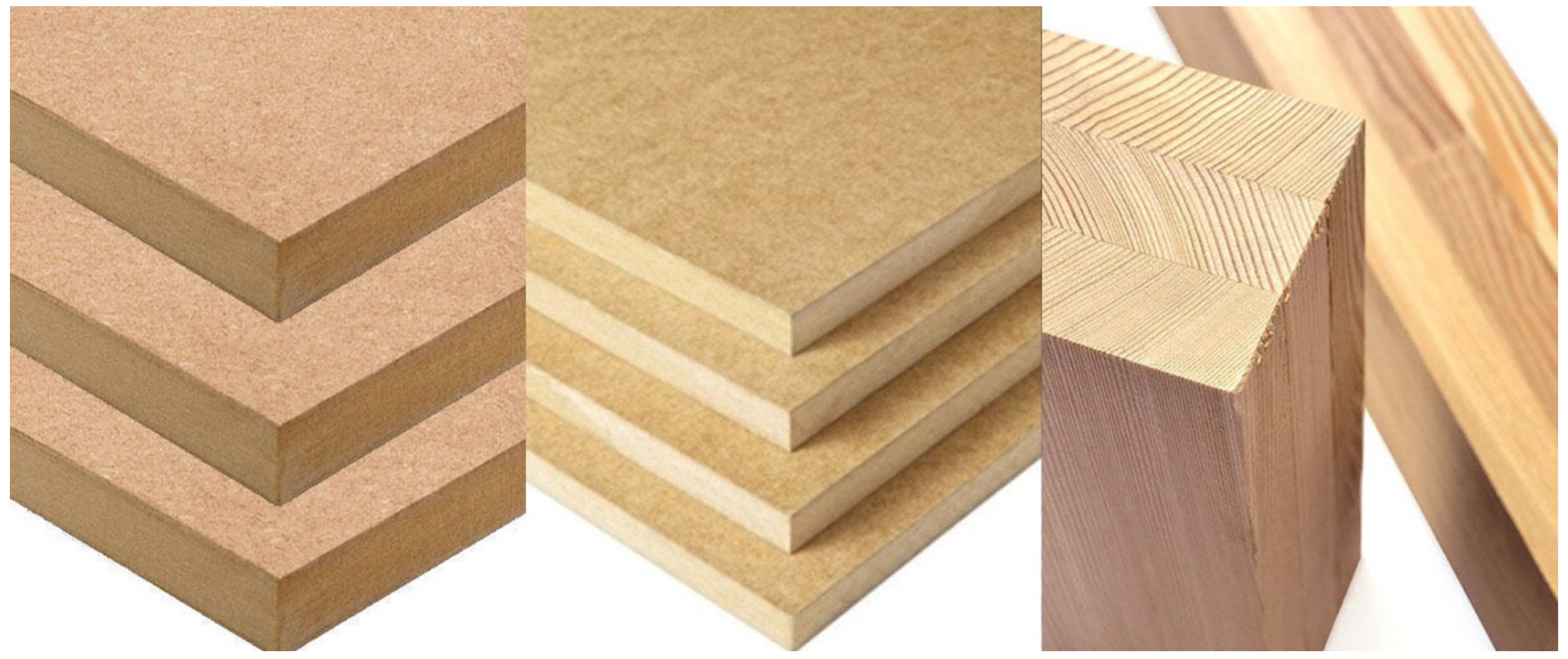
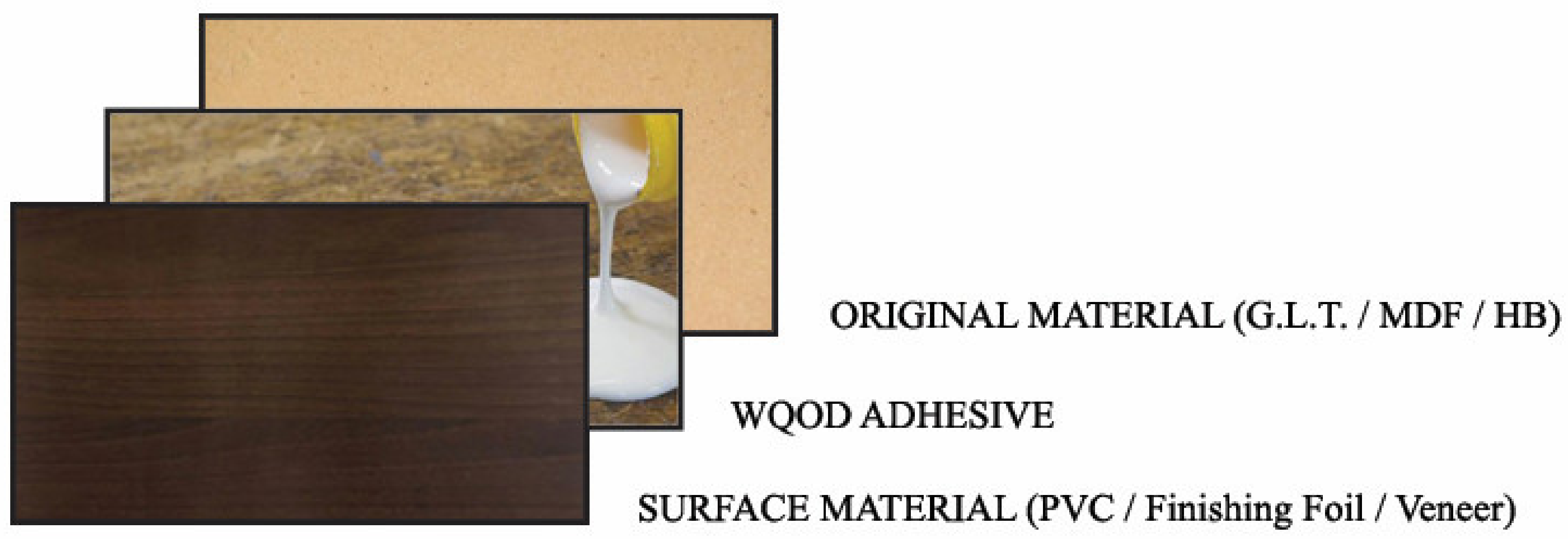
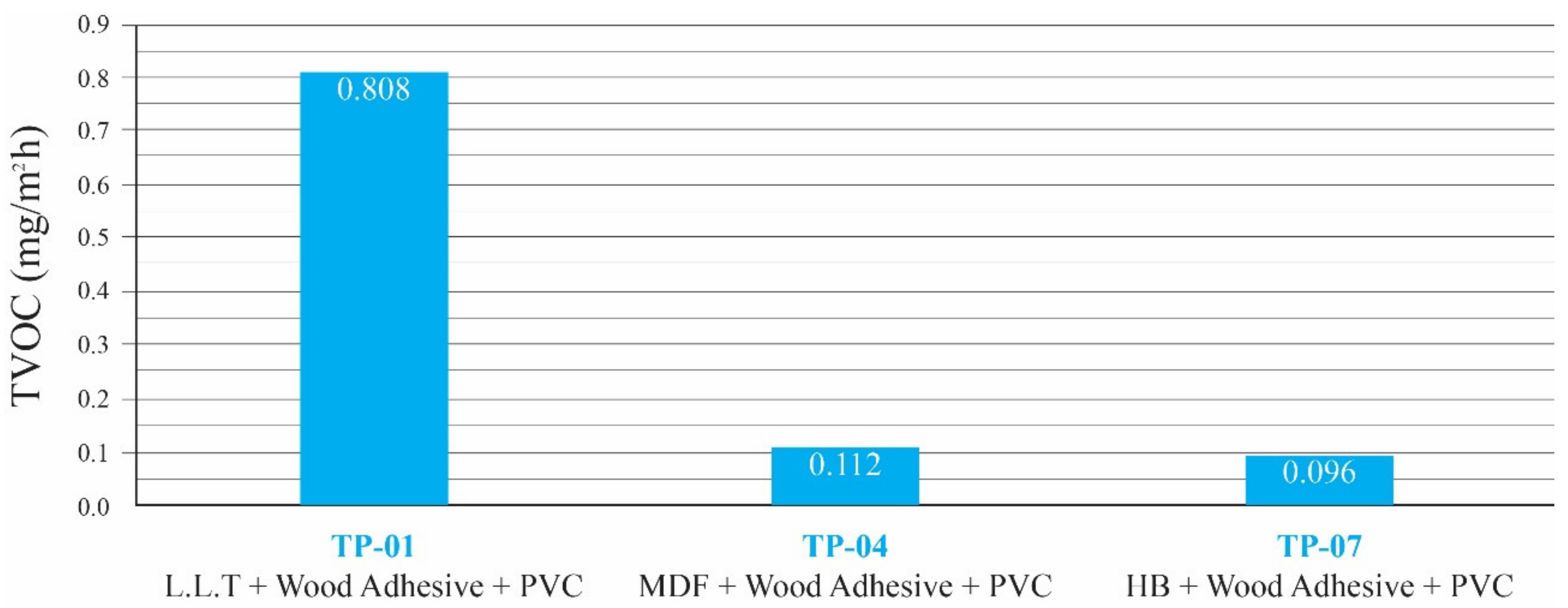
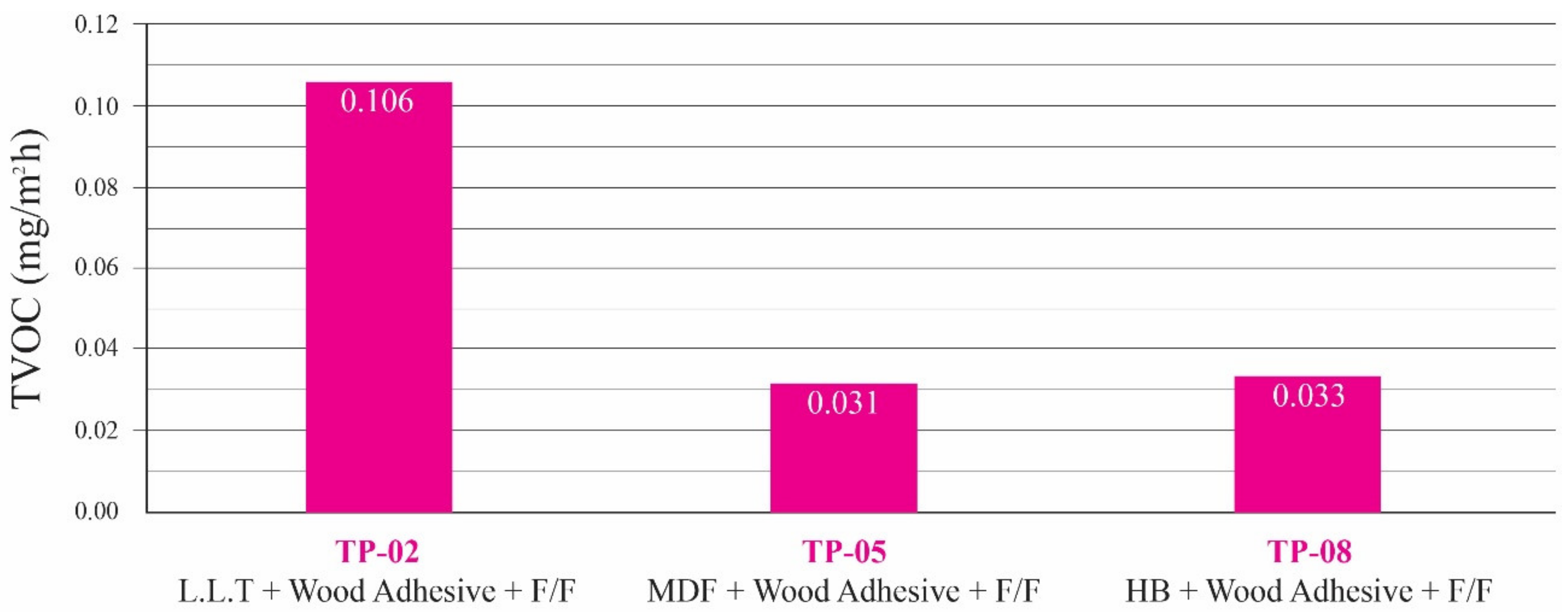

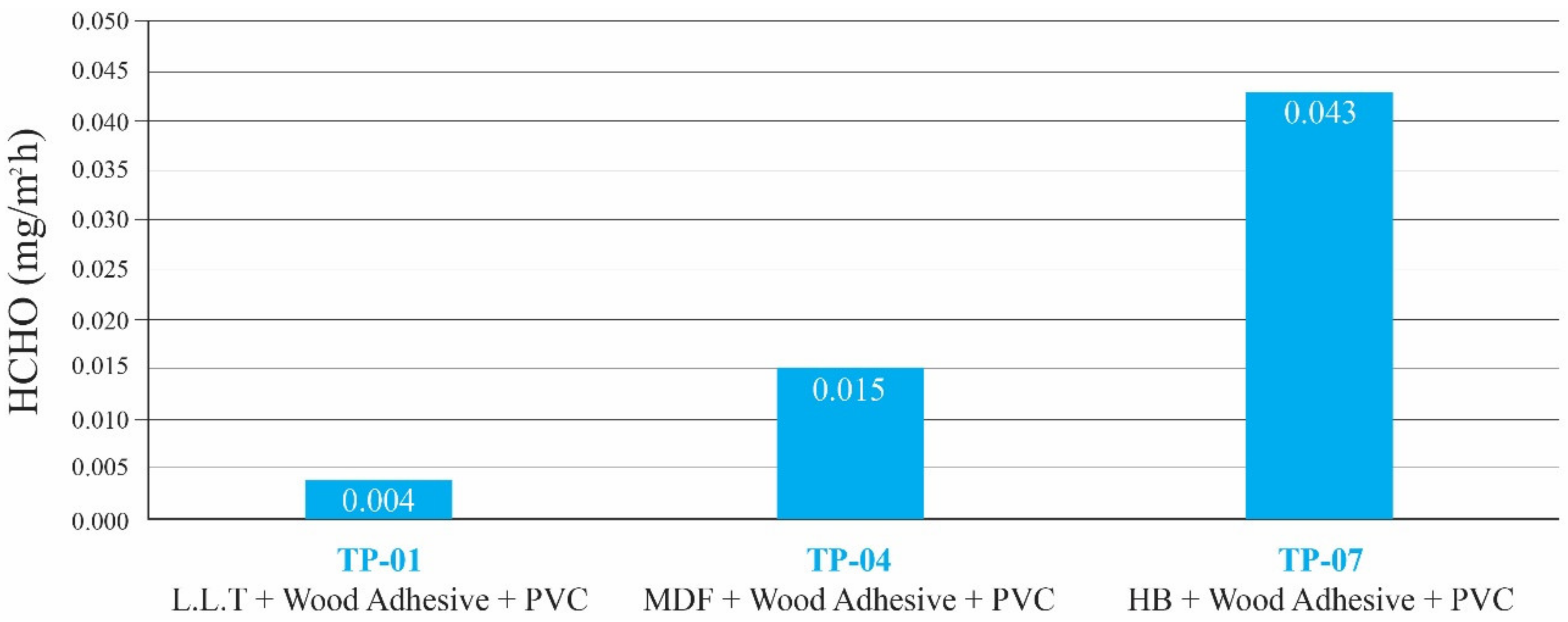
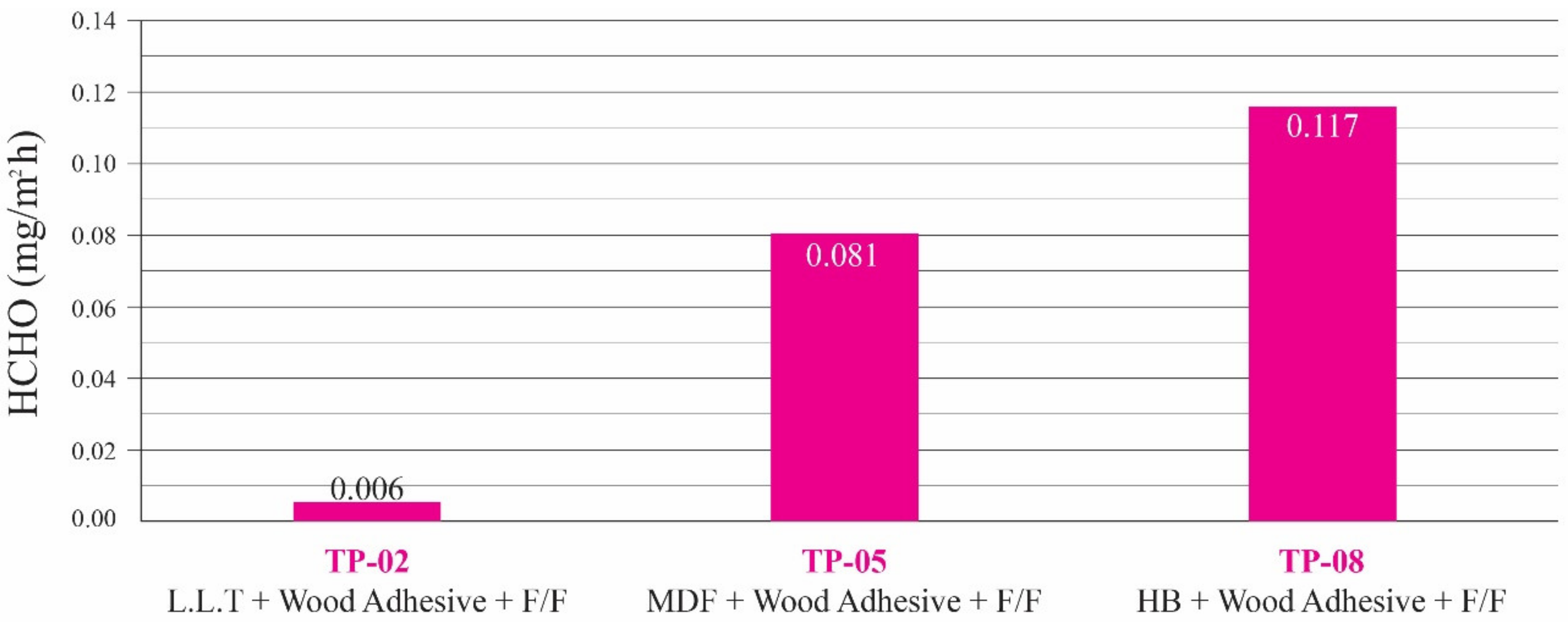
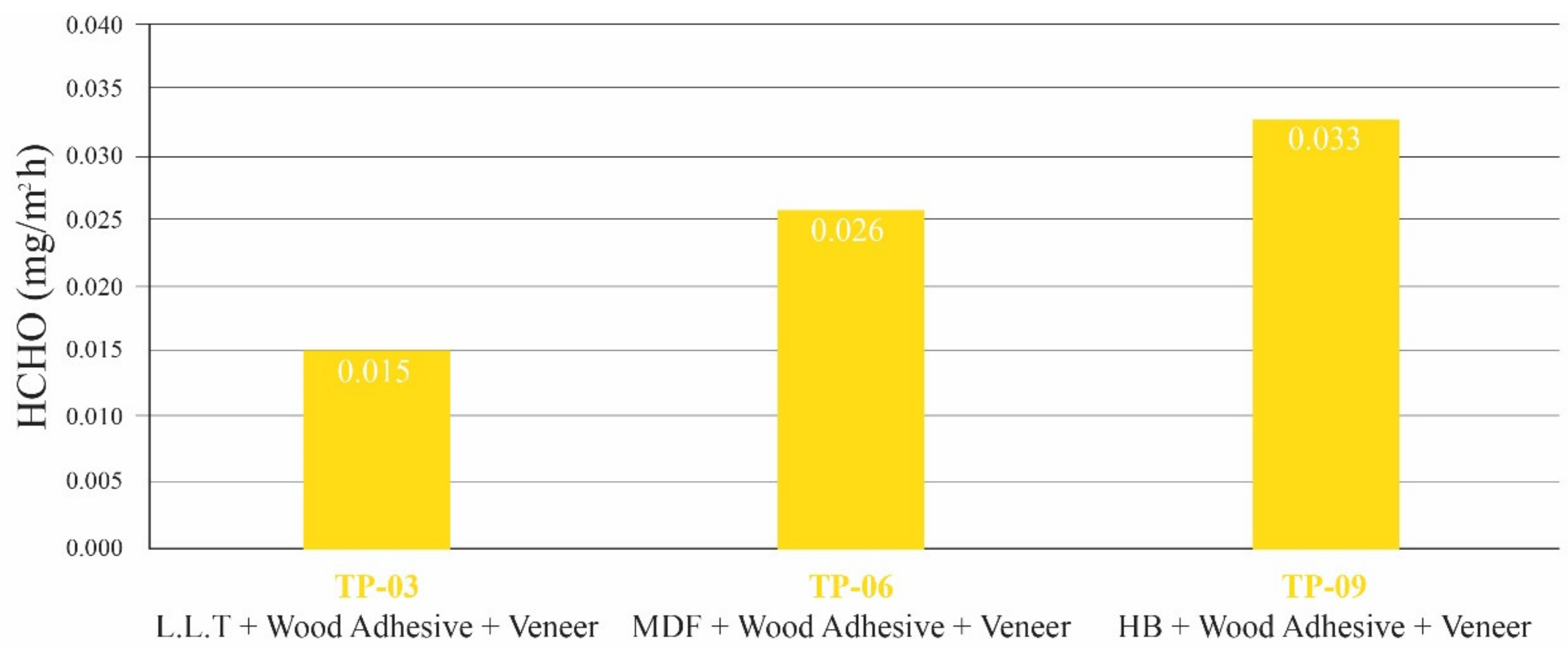
| Types | Density | EPA HCHO Emission Standards |
|---|---|---|
| Hard Fiberboard (HB) - Veneer Core | More than 0.85 g/cm3 | 0.05 ppm |
| HB - Composite Core | ||
| Medium-Density Fiberboard (MDF) | 0.35 g/cm3–0.85 g/cm3 | 0.11 ppm |
| Name | Material Composition for Test Piece | Production Date | Test Start Date |
|---|---|---|---|
| TP-01 | LLT + Wood Adhesive + PVC | 04/09/2021 | 28/09/2021 |
| TP-02 | LLT + Wood Adhesive + F/F | 04/09/2021 | 28/09/2021 |
| TP-03 | LLT + Wood Adhesive + Veneer | 04/09/2021 | 28/09/2021 |
| TP-04 | MDF + Wood Adhesive + PVC | 04/10/2021 | 12/10/2021 |
| TP-05 | MDF + Wood Adhesive + F/F | 04/10/2021 | 12/10/2021 |
| TP-06 | MDF + Wood Adhesive + Veneer | 04/10/2021 | 12/10/2021 |
| TP-07 | HB + Wood Adhesive + PVC | 02/11/2021 | 05/11/2021 |
| TP-08 | HB + Wood Adhesive + F/F | 02/11/2021 | 05/11/2021 |
| TP-09 | HB + Wood Adhesive + Veneer | 02/11/2021 | 05/11/2021 |
| Surface Material | Raw Material | LLT | MDF | HB | Test Piece Retention Period after Production (Days) |
|---|---|---|---|---|---|
| Retention Period (Days) | 90 | 180 | 180 | ||
| PVC | 30 | TP-01 | 14 | ||
| 45 | TP-04 | 8 | |||
| 70 | TP-07 | 3 | |||
| F/F | 30 | TP-02 | 14 | ||
| 45 | TP-05 | 8 | |||
| 70 | TP-08 | 3 | |||
| Veneer | 30 | TP-03 | 14 | ||
| 45 | TP-06 | 8 | |||
| 70 | TP-09 | 3 |
| Measuring Items | Measuring Instruments | Measurement Range/Accuracy |
|---|---|---|
| VOCs |
|
|
| HCHO |
|
|
| Room Temperature Relative Humidity |
|
|
| Name | Material Composition for Test Piece | Emission Intensity (mg/m2h) | Evaluation | |
|---|---|---|---|---|
| TVOC | HCHO | |||
| TP-01 | LLT + Wood Adhesive + PVC | 0.808 | 0.004 | Unsuitable |
| TP-02 | LLT + Wood Adhesive + F/F | 0.112 | 0.015 | Suitable |
| TP-03 | LLT + Wood Adhesive + Veneer | 0.096 | 0.043 | Suitable |
| TP-04 | MDF + Wood Adhesive + PVC | 0.106 | 0.006 | Suitable |
| TP-05 | MDF + Wood Adhesive + F/F | 0.031 | 0.081 | Suitable |
| TP-06 | MDF + Wood Adhesive + Veneer | 0.033 | 0.117 | Suitable |
| TP-07 | HB + Wood Adhesive + PVC | 0.231 | 0.015 | Suitable |
| TP-08 | HB + Wood Adhesive + F/F | 0.043 | 0.026 | Suitable |
| TP-09 | HB + Wood Adhesive + Veneer | 0.036 | 0.033 | Suitable |
Publisher’s Note: MDPI stays neutral with regard to jurisdictional claims in published maps and institutional affiliations. |
© 2022 by the authors. Licensee MDPI, Basel, Switzerland. This article is an open access article distributed under the terms and conditions of the Creative Commons Attribution (CC BY) license (https://creativecommons.org/licenses/by/4.0/).
Share and Cite
Jung, C.; Al Qassimi, N. Investigating the Emission of Hazardous Chemical Substances from Mashrabiya Used for Indoor Air Quality in Hot Desert Climate. Sustainability 2022, 14, 2842. https://doi.org/10.3390/su14052842
Jung C, Al Qassimi N. Investigating the Emission of Hazardous Chemical Substances from Mashrabiya Used for Indoor Air Quality in Hot Desert Climate. Sustainability. 2022; 14(5):2842. https://doi.org/10.3390/su14052842
Chicago/Turabian StyleJung, Chuloh, and Nahla Al Qassimi. 2022. "Investigating the Emission of Hazardous Chemical Substances from Mashrabiya Used for Indoor Air Quality in Hot Desert Climate" Sustainability 14, no. 5: 2842. https://doi.org/10.3390/su14052842
APA StyleJung, C., & Al Qassimi, N. (2022). Investigating the Emission of Hazardous Chemical Substances from Mashrabiya Used for Indoor Air Quality in Hot Desert Climate. Sustainability, 14(5), 2842. https://doi.org/10.3390/su14052842







